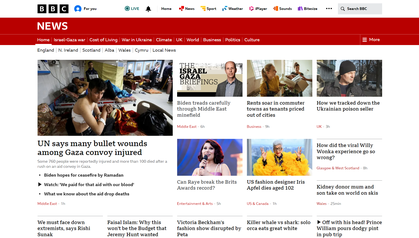Popular News - An Overview
Popular News - An Overview
Blog Article
The Best Guide To Popular News
Table of ContentsOur Popular News PDFsGetting My Popular News To WorkThe 15-Second Trick For Popular NewsSome Known Details About Popular News
Age is additionally a consider the means people see the role of social networks. Younger social media information consumers are more probable to say it has actually affected their discovering right. Regarding half of social media news customers ages 18 to 29 (48%) claim information on social media sites makes them better notified, contrasted with 37% of those 30 to 49, 28% of those 50 to 64, and 27% of those 65 and older.
Study on a state's brand-new tax code likely won't create the very same passion throughout state boundaries. Periodically specialists can help center a bigger nationwide story that influences even more than just a city or state.
If you are releasing newsworthy research, loop in MarComm prior to the article being published to ensure that the pitch can emphasize the newest component of the story: the magazine of the research study - Popular News. Events and news that entail prominent figures are more probable to produce media insurance coverage. Visits from nationwide figures typically call for months of preparation due to expected area interest
Some Known Questions About Popular News.
Stories often entail some kind of dispute. By meaning, these tales are usually questionable to some level. University staff and faculty are generally viewed as unbiased experts. We can help mitigate potential reputational threat with these stories while also enhancing the chances of producing coverage. While most of the above news values are interwoven, human rate of interest tales frequently stand apart.
Human rate of interest aspects can include information value to various other stories that could seem lacking in the other worths. The uniqueness or quirk of a scenario can assist influence whether an information electrical outlet is most likely to cover a story. While this is not an exhaustive list, examining to see if your story or occasion has these top qualities before calling us will aid you establish which elements hold the most information worth.

There is also significant evidence that more consumers can begin to pay for news in the futureif publishers can recognize them and serve them well. Fifty percent of those who do not pay for news proactively seek news and appear like clients in numerous means. And virtually 2 in 10 of those who do not subscribe to information now suggest they are inclined to start to pay in the future.
Facts About Popular News Revealed
We after that ask a set of concerns to determine whether individuals spend for certain sorts of information sources. We asked individuals to call the check my blog sources they use most oftenwhether they pay for them or nothow they use them, the particular points they think about vital regarding them, and some relevant inquiries about the cost and moved here worth of that resource.

Greater than 4 in 10 additionally mention the fact that family and friends sign up for the very same item. Even more than a third of individuals claim they initially subscribed in response to a discount rate or promotion. In print, people also are relocated heavily to sign up for obtain coupons that save them cash, something that has untapped implications in electronic.
7 Simple Techniques For Popular News
Concerning half are "information applicants," indicating they proactively seek out information instead of largely running into it in a much more passive means, though the news that nonpayers are looking for (in the meantime, at the very least) is usually regarding national politics. Like clients, many of these individuals additionally get news several times a day, make use of the information in methods comparable to subscribers, and have an interest in comparable subjects, consisting of international or worldwide news.
We asked every person that informed us they have a regular cost-free source of information how most likely they would be to navigate to these guys spend for it. Greater than a quarter (26 percent) claim they would certainly be at the very least somewhat most likely to begin paying for itand 10 percent are really or incredibly likely. These most likely payers have a tendency to be news applicants, and they also often tend to be people that currently pay for an information membership along with the resource they adhere to absolutely free.
Of those who do pay, 54 percent subscribe to newspapers in print or electronically, which represents 29 percent of Americans generally. Many of them acquire a print publication in addition to their paper and spend for 2 to 4 news sources in overall, some even much more. And while 53 percent are long-time subscribers (5+ years), more than a quarter (27 percent) have actually acquired their paper registration within the previous year.
Couple of print clients think it likely they will certainly switch to a digital-only registration in the future, and majority of those who choose digital have never spent for a print version of the same resource (Popular News). Totally 75 percent of paper payers state they largely read the paper in print, while 21 percent are mostly digital individuals, and 4 percent explain themselves as uniformly split
Report this page